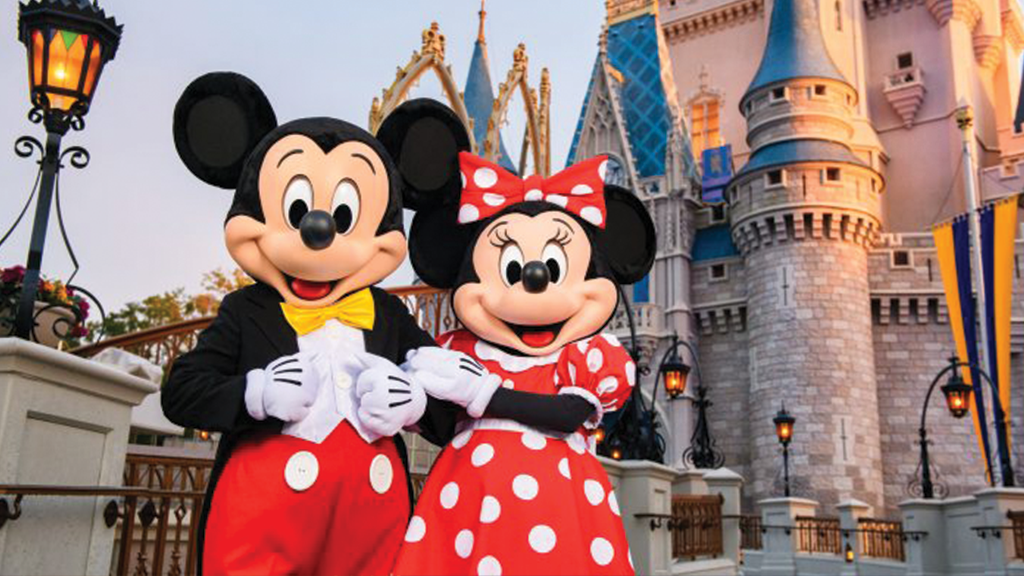Walt Disney World ® Resort
Disney Plans to Expand Parks Investment, Doubling Capital Expenditures Over 10 Years

The Walt Disney Company is developing plans to accelerate and expand investment in its Parks, Experiences and Products segment to nearly double capital expenditures over the course of approximately 10 years to roughly $60 billion, including by investing in expanding and enhancing domestic and international parks and cruise line capacity.
Today, Senior Disney executives, including Chief Executive Officer Bob Iger and Disney Parks, Experiences and Products Chairman Josh D’Amaro, gathered with Wall Street analysts and investors at Walt Disney World Resort in Orlando, Florida for an investor summit focused on Disney’s Parks business and its track record of investing aggressively and intelligently in experiences that leverage the powerful and ever-growing library of Disney stories, which has proven incredibly effective.
“We’re incredibly mindful of the financial underpinning of the company, the need to continue to grow in terms of bottom line, the need to invest wisely so that we’re increasing the returns on invested capital, and the need to maintain a balance sheet, for a variety of reasons,” said Bob Iger. “The company is able to absorb those costs and continue to grow the bottom line and look expansively at how we return value and capital to our shareholders.”
“We have an ambitious growth story that is supported by a proven track record and a bold vision for the future of our Parks business,” said D’Amaro.
Central to the business’s growth strategy will be a focus on stories, scale, and fans.
STORIES
All over the world, Disney leverages its incomparable library of intellectual property through immersive storytelling experiences in its Parks and Resorts, on board its cruise ships, and through its consumer products and licensing business. The Parks business serves as a powerful platform where Disney’s beloved stories come to life in innovative ways, and where fans across generations and geographies can connect with and explore the Disney brands and franchises they love, from Avatar to Zootopia, and everything in between.
Disney continuously reimagines its theme park offerings to appeal to more guests by incorporating new stories from its popular films and series. Disney Parks has seen growth following previous periods of significant investment, which included the additions of Cars Land at Disney California Adventure, Star Wars Galaxy’s Edge at Disneyland Resort and Disney’s Hollywood Studios at Walt Disney World, Avengers Campus at Disney California Adventure and Walt Disney Studios Park in Paris, and more.
Today, as Disney considers future growth opportunities, there is a deep well of stories that have yet to be fully explored in its theme parks.
Already, new Frozen-themed lands are coming to Hong Kong Disneyland, Walt Disney Studios Park in Paris and Tokyo Disney Resort, as well as a Zootopia-themed land at Shanghai Disney Resort. However, Disney will explore even more characters and franchises, including some that haven’t been leveraged extensively to date, as it embarks on a new period of significant growth domestically and internationally in its parks and resorts.
“We have a wealth of untapped stories to bring to life across our business,” said D’Amaro. “Frozen, one of the most successful and popular animated franchises of all time, could have a presence at the Disneyland Resort. Wakanda has yet to be brought to life. The world of Coco is just waiting to be explored. There’s a lot of storytelling opportunity.”
SCALE
Today, Disney has the largest physical footprint of any global theme park travel business, with 12 parks across six sites around the world.[1] Its newest resort, Shanghai Disney Resort, opened in 2016. Disney Cruise Line visits 94 ports in 40 countries, and Disney’s industry-leading consumer products division brings Disney IP into fans’ homes across the globe.
Notably, Walt Disney World Resort is twice the size of the island of Manhattan, Disneyland is the most “Instagrammed” place on Earth, and tens of millions of guests travel on Disney’s transportation networks each year.
Disney’s Parks business is a key driver of value creation for the company, and positive segment results in recent past quarters through FY23Q3 have come in part from strong performance at Disney’s international parks, particularly those in Asia. Shanghai Disney Resort and Hong Kong Disneyland, which have both shown meaningful growth coming out of the pandemic through Q3 FY23, have even further growth opportunities with the expansions set to open later this year.
However, in addition to development plans already underway, there is significant room for further expansion on land and at sea.
“We stand alone when it comes to scale,” said D’Amaro. “And while our scale is impressive, we have no shortage of space or regions of the world in which to tell new stories.”
In fact, Disney Parks has over 1,000 acres of land for possible future development to expand theme park space across its existing sites – the equivalent of about seven new Disneyland Parks.
Meanwhile, Disney Cruise Line serves as a powerful ambassador for the brand in ports and markets around the globe beyond its theme parks, including Australia and New Zealand for the first time later this year, extending the reach of Disney’s high-quality experiences. As previously announced, over the next two years, Disney will nearly double the worldwide capacity of its cruise line, adding two ships in fiscal year 2025 and another in 2026, delivering even further growth potential and introducing new markets to Disney experiences, including a new homeport in Singapore beginning in 2025 to expand its reach further into the Asia-Pacific region.
FANS
Today, Disney has seven of the top ten most attended theme parks in the world, including Walt Disney World’s Magic Kingdom Park, which has been the #1 attended theme park on earth for decades. Disney Parks welcome approximately 100 million guests each year.
Yet there is still enormous untapped potential for reaching more consumers. According to Disney’s internal research, there is an addressable market of more than 700 million people with high Disney affinity it has yet to reach with its Parks. In fact, for every one guest who visits a Disney Park, there are more than ten people with Disney affinity who do not visit the Parks.[2]
“Ultimately what is most important to us is the relationship that we have with every guest,” said D’Amaro. “Guests can spend a day with us at our Parks, a week with us on a Cruise, or the rest of their lives with us through Disney Vacation Club membership.”
As Disney expands its footprint and offerings, not only will the company be able to reach more of its existing fans, but it will create new fans and loyal consumers.
As the company develops plans to accelerate and expand investment in its Parks business, it looks forward to introducing fans to more of the most powerful characters and stories, expanding its global footprint, advancing its state-of-the-art commercial capabilities, and leveraging its unmatched global talent to forge relationships with new generations of fans around the world.
“Throughout our history, we’ve created enormous growth by investing the right amount of capital into the right projects at the right moment,” said Iger. “We are planning to turbocharge our growth yet again with a robust amount of strategic investment in this business.”
Forward-Looking Statements
Certain statements in this post may constitute “forward-looking statements” within the meaning of the Private Securities Litigation Reform Act of 1995, including statements regarding expectations; strategy or focus; guidance; priorities; plans or opportunities (including for expansion and growth) and potential impact on future performance; potential future growth or performance and anticipated drivers of growth or performance; future capital expenditures; trends; drivers of demand; goals; product or service offerings (including nature, timing and pricing); consumer sentiment, behavior or demand; total addressable market and related drivers; value of our intellectual property; and other statements that are not historical in nature. Any information that is not historical in nature included in this discussion is subject to change. These statements are made on the basis of management’s views and assumptions regarding future events and business performance as of the time the statements are made. Management does not undertake any obligation to update these statements.
Actual results may differ materially from those expressed or implied. Such differences may result from actions taken by the Company, including restructuring or strategic initiatives (including capital investments, asset acquisitions or dispositions, new or expanded business lines or cessation of certain operations), our execution of our business plans (including the content we create and IP we invest in, our pricing decisions, our cost structure and our management and other personnel decisions), our ability to quickly execute on cost rationalization while preserving revenue, the discovery of additional information or other business decisions, as well as from developments beyond the Company’s control, including:
the occurrence of subsequent events;further deterioration in domestic and global economic conditions or a failure of conditions to improve as anticipated;deterioration in or pressures from competitive conditions, including competition to create or acquire content, competition for talent and competition for advertising revenue;consumer preferences and acceptance of our content, offerings, pricing model and price increases, and corresponding subscriber additions and churn, and the market for advertising sales on our DTC services and linear networks;health concerns and their impact on our businesses and productions;international, political or military developments;regulatory and legal developments;technological developments;labor markets and activities, including work stoppages;adverse weather conditions or natural disasters; andavailability of content.
Such developments may further affect entertainment, travel and leisure businesses generally and may, among other things, affect (or further affect, as applicable):
our operations, business plans or profitability, including direct-to-consumer profitability; demand for our products and services;the performance of the Company’s content;our ability to create or obtain desirable content at or under the value we assign the content;the advertising market for programming;income tax expense; andperformance of some or all Company businesses either directly or through their impact on those who distribute our products.
Additional factors are set forth in the Company’s Annual Report on Form 10-K for the year ended October 1, 2022, including under the captions “Risk Factors,” “Management’s Discussion and Analysis of Financial Condition and Results of Operations,” and “Business,” quarterly reports on Form 10-Q, including under the captions “Risk Factors” and “Management’s Discussion and Analysis of Financial Condition and Results of Operations,” and subsequent filings with the Securities and Exchange Commission.
The terms “Disney,” “company,” “we,” and “our” are used in this post to refer collectively to The Walt Disney Company and the subsidiaries through which its various businesses are actually conducted.
[1] The Company earns royalties on revenues generated by the Tokyo Disney Resort, which is owned and operated by Oriental Land Co., Ltd., a third-party Japanese company.
[2] Note: Consumer opportunity based on analysis of minimum level of Disney branded spending and current parks visitation.





